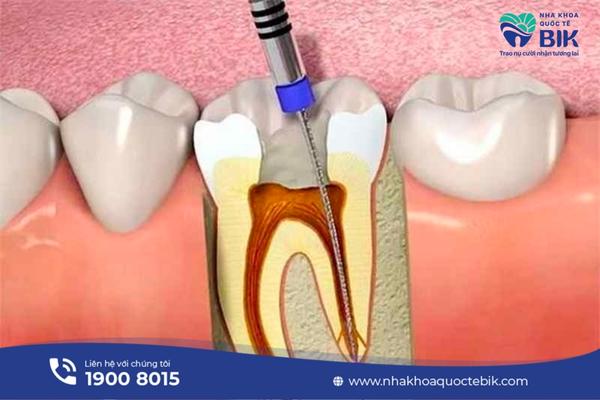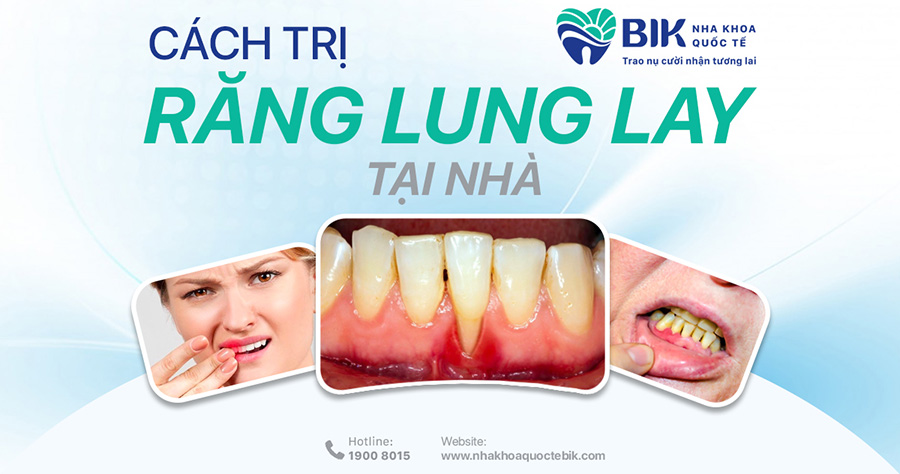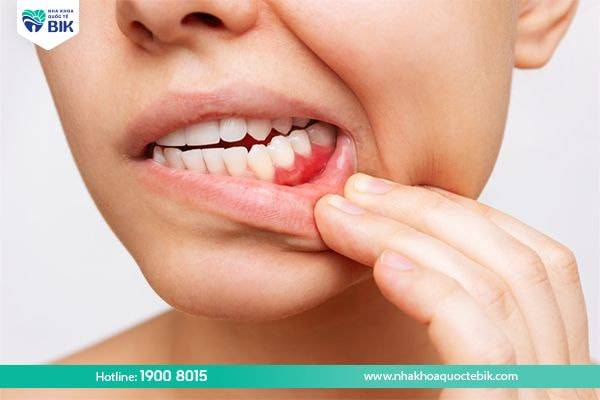Tooth decay is one of the most common dental diseases, it can occur in all subjects, all ages. The cause of tooth decay is often due to improper oral hygiene habits as well as an unhealthy diet. If tooth decay progresses, it can cause serious complications. Therefore, you need to know about the stages of tooth decay to have effective prevention and treatment methods.
1. Causes of tooth decay
The main cause of tooth decay, whether severe or mild, is bacteria that corrode the tooth structure. The habit of eating foods high in sugar or improper oral hygiene will increase the ability of harmful bacteria to grow, thereby increasing the risk of tooth decay.
Sweet foods such as cakes, candies, milk, chocolate, jam, … contain many exogenous sugars, this is the type of sugar that can cause high tooth decay. After eating these foods, plaque will form in the crevices and roots of the teeth. If this plaque is not completely cleaned, it can create favorable conditions for harmful bacteria to grow, leading to tooth decay.
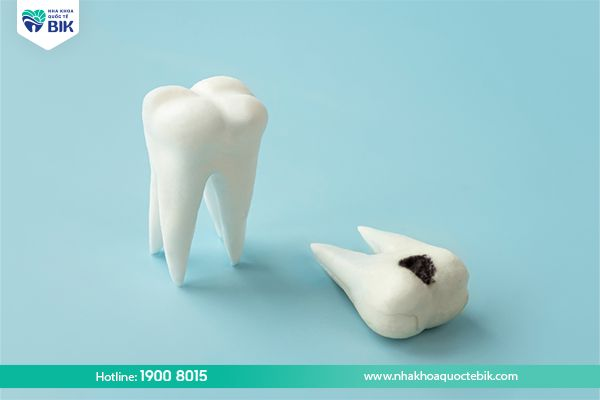
2. Stages of tooth decay
Tooth decay is often divided into the following stages:
2.1. Stage 1: Demineralization
The structure of the tooth has an outer layer of a type of tissue called enamel. Enamel is the hardest tissue in the body and is composed mainly of minerals.
But once the tooth is exposed directly to the acid produced by plaque bacteria, over time the enamel will begin to lose minerals. When this process occurs, white spots will appear on one of the teeth. This area of mineral loss is an early sign that tooth decay is occurring.
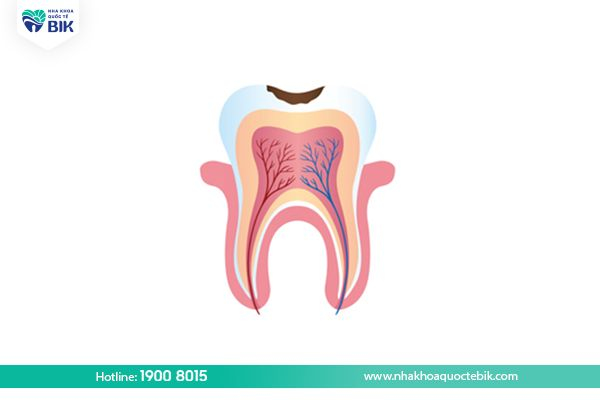
2.2. Stage 2: Enamel decay
If the patient does not detect and treat early, the tooth decay process will continue, the enamel will gradually break down. The white spots on the teeth will begin to turn brown. When the enamel is weakened, small holes in the teeth, also known as cavities or tooth decay, can form. These cavities will be filled to restore chewing ability and aesthetics.
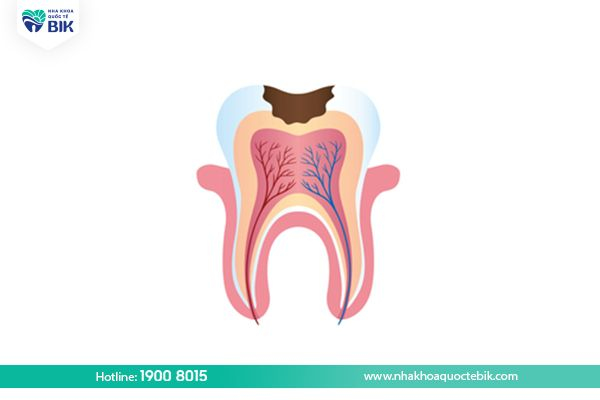
2.3. Stage 3: Dentin decay
When the decay reaches the dentin, the decay will develop at a faster rate. Dentin contains tubes leading to the nerves of the tooth. Therefore, if the dentin is affected, the tooth will show signs of sensitivity, especially when eating hot or cold foods or drinks.
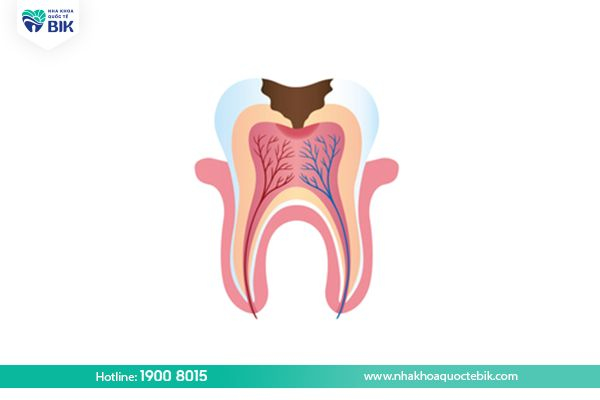
2.4. Stage 4: Pulpitis
This is a fairly severe stage of tooth decay, causing a lot of damage to the teeth, especially the pulp. The pulp is the innermost layer of the tooth that contains nerves and blood vessels that help keep the tooth healthy. These nerves also play a role in providing sensation to the tooth when performing the chewing function. When the pulp is damaged, the tooth can be irritated, pain and sensitivity appear, and the tooth begins to swell.
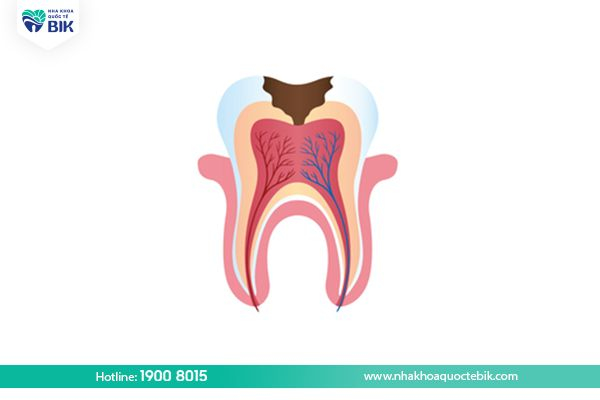
2.5. Stage 5: Tooth abscess
When tooth decay progresses deep into the tooth pulp, harmful bacteria can invade and attack, causing infection. Increasing inflammation in the tooth can lead to a pus pocket forming at the root of the tooth, outside the gum, commonly known as an abscess.
A tooth abscess can cause severe pain that can radiate down to the jawbone. Other signs may include swelling of the gums, face or jaw, fever and swollen lymph nodes in the patient’s neck.
This is a very serious tooth decay condition that needs to be treated promptly because the infection can spread to the jawbone as well as other areas of the patient’s head and neck. In some cases, the doctor may prescribe treatment that includes removing the decayed tooth to protect the healthy teeth next to it.
3. Dental treatment for tooth decay
There are many ways to treat tooth decay that many people pass on to each other, but these methods only apply to cases where the patient has mild tooth decay or cannot go to a dental facility for treatment to completely end the disease. Therefore, as soon as the symptoms of tooth decay are detected, the patient should go to a dental facility to be intervened with appropriate measures and advanced technology to effectively treat tooth decay.
Based on each type of tooth decay condition, doctors can prescribe different treatment methods, including:
3.1. Filling cavities
When the patient detects it in time, the cavity is still mild and has not reached the pulp, the doctor will clean the cavities, then fill the hole in the tooth. This method will prevent harmful bacteria from directly attacking the damaged tooth, helping to protect the tooth in the long term.
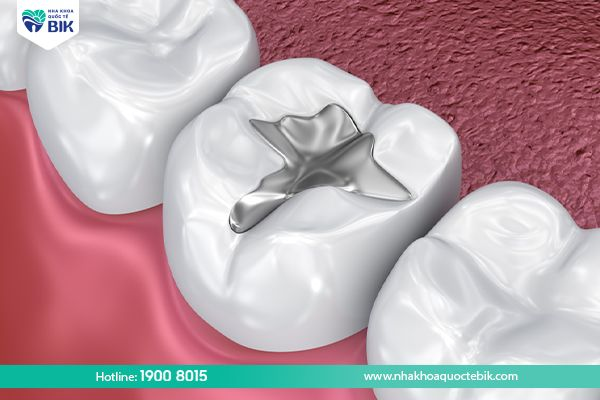
3.2. Root canal treatment
Once the pulpitis and pulp necrosis stages have been reached, the patient needs to undergo root canal treatment. The doctor will thoroughly remove the damaged pulp, otherwise, after treatment, it may cause tooth decay and pulpitis to recur. After the root canal treatment, the doctors will fill the tooth or cover it with porcelain to restore the tooth body, ensuring long-term chewing function.
3.3. Extracting decayed teeth
Extracting decayed teeth is a method applied to severe tooth decay that cannot be treated with the two methods of filling or removing the root canal, at this time the patient must extract the decayed tooth. This helps prevent the bacteria that cause tooth decay from spreading to healthy teeth next to it. Immediately after extraction, the patient can have a dental implant to maintain chewing function and help prevent complications caused by tooth loss.
4. How to prevent tooth decay
To prevent tooth decay, you should note the following:
– Brush your teeth at least twice a day, especially after each meal to remove remaining food plaque.
– Replace your toothbrush every 3-4 months to prevent bacteria from accumulating and attacking tooth enamel.
– Use fluoride toothpaste to help teeth stay strong and healthy.
– Combine dental floss to remove food particles between teeth, be careful when using to avoid damaging the gums.
– Maintain a scientific diet, supplement with necessary vitamins and minerals to support increased resistance to help the body fight harmful bacteria.
– Limit eating foods high in sugar or starch because they are easily metabolized and create conditions for bacteria to grow in the oral cavity.
– Visit the dentist regularly at least every 6 months to ensure regular check-ups of oral health.

So tooth decay is a relatively common disease, originating from the cause of patients not cleaning their teeth properly as well as the habit of eating foods containing a lot of sugar,… To prevent dangerous complications as well as the progression of tooth decay, you can choose BIK International Dental Clinic as a reliable treatment place with a team of highly specialized and skilled doctors.

